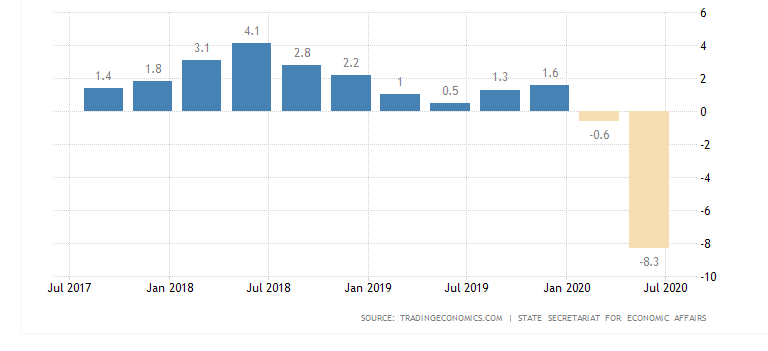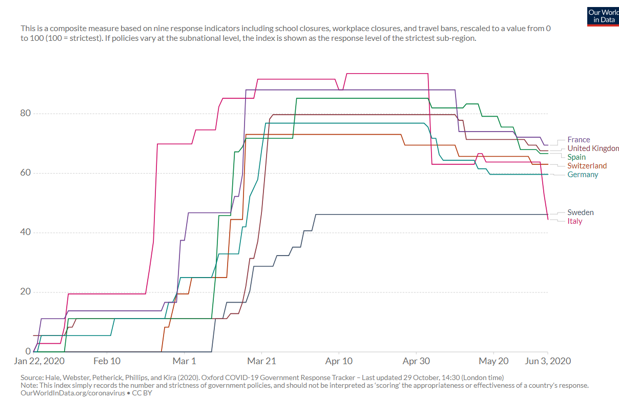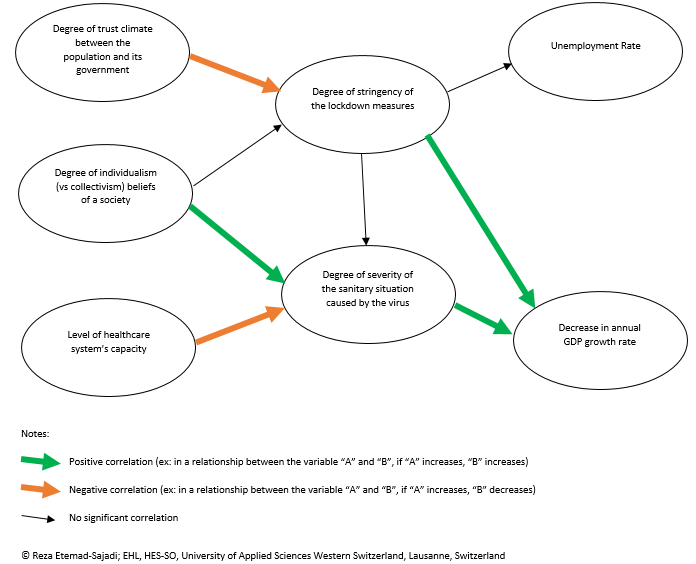
By Dr. Reza Etemad-Sajadi
November 5, 2020 – What we have learned from the first COVID-19 wave? Insights into how different European countries reacted to the pandemic and how the diverse coping strategies affected their respective economies in the first half of this year. Interesting lessons to be learnt as we enter into a prolonged period of the pandemic.
The world has come to understand that the COVID-19 pandemic is wreaking havoc on the global economy and will continue to do so for some time. The table below shows the annual growth rate of Switzerland’s GDP, which shrank by a record 8.3% year-on-year in the second quarter of 2020.
Swiss GDP: Annual Growth Rate
This article aims to share five interesting findings that were discovered after several indicators of 34 European countries were analyzed. The data were considered between January and August 2020. The indicators were the following by country:
- Degree of stringency of the lockdown measures
- GDP annual growth rate
- Unemployment rate
- General level of trust in government
- Degree of individualism vs collectivism beliefs of the population
- Degree of severity of the health situation caused by the virus
- Healthcare system capacity
The graph below compares the severity of the lockdown measures according to several European countries. We see that Sweden was constantly less restrictive on the lockdown measures. In parallel, we observe that Italy was one of the first European countries affected by the virus which explains the severity of the lockdown measures. As far as Switzerland is concerned, one can claim that, in general, the lockdown was less severe compared to the other European countries. Indeed, the Swiss strategy consisted in relying on the population to follow the government’s health recommendations and for citizens to exhibit personal responsibility.
COVID-19: Government response stringency index
Our model and the relationships between the different variables
Five conclusions to keep in mind
- Analyzing the situation between January 2020 and August 2020, we found that there is a significant relationship between the severity of the lockdown measures decided by the governments and the decrease in annual GDP growth rate of the relevant countries. Indeed, after the first COVID wave in Europe (spring 2020), we found that the strictness of the lockdown measures explained 9.1% of the drop in GDP. In parallel, if we also consider the relative number of deaths by country, our model explains 20.7% of the fall in GDP. In other words, the severity of the lockdown and the severity by which the countries have been affected by the virus, both explain one-fifth of the decrease in the GDP growth rate.
- Focusing on the increase in the unemployment rate between January 2020 and August 2020 in Europe, our model shows that the severity of the measures linked to the lockdown has no significant impact on the increase in the unemployment rate. That said, this analysis covers a short period of time. It would be relevant to examine the situation over a longer period of time. Indeed, the negative impact of the pandemic will potentially have a lagging impact on joblessness, therefore this relationship should be analyzed over the coming months and into 2021.
- We compared the “cultural distance” focusing on the level of individualism vs. collectivism of different countries. This dimension refers to the degree of interdependence a society maintains among its members. It has to do with whether people’s self-image is defined in terms of “I” or “We”. We identified that there is a relationship between the “individualism beliefs” of a society and its impact on the severity of the health issue. On the contrary, societies that espouse “collectivism beliefs” had fewer deaths (per one million people). Indeed, 24% of the severity of the virus’ damage is explained by the degree of individualism (vs. collectivism) of the population.
- There is a significant relationship between the population’s level of trust in government and the severity of the lockdown measures. In countries where the level of trust in the government is high, the lockdown measures tended to be less strict. This shows that in these countries, the governments decided to let their people have more freedom, counting on them to be responsible and follow the rules (e.g. social distancing, mask wearing, etc.). For example, in Sweden’s case, the fact that the lockdown measures were relatively flexible indicates that the population trusts the government and follows recommendations to limit unnecessary movement.
- Comparing the health care situation in European countries, we see that 9.3% of deaths (per one million people) is explained by the healthcare system’s capacity to absorb sick people in each country. Germany is the leader in Europe with eight beds per 1,000 people. In parallel, even if the lockdown measures significantly contributed to reduce the first COVID wave, the impact of the strictness of its implementation is not obvious. Indeed, in our model, there is no significant relationship between the severity of the lockdown measures and the reduction in the number of deaths. That said, in a multifactor context, it is not possible to generalize this relationship.
In order to conclude, one can claim that each country has its reality and therefore, it is difficult to compare the situations. There is no doubt that the sanitary crisis is still present. In the future, the challenge will be to implement “smart” and adjustable lockdown measures according to each context, in order to save lives as much as possible and at the same time reduce the negative impact on the economy and the entire society.




